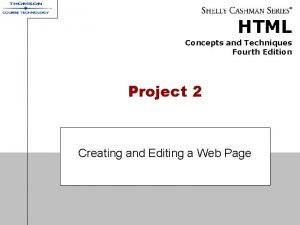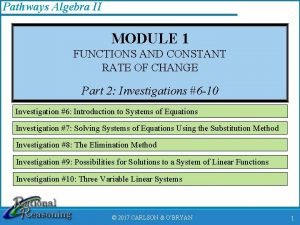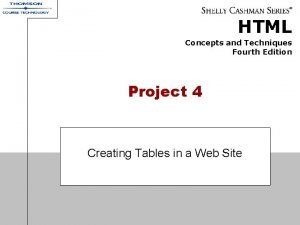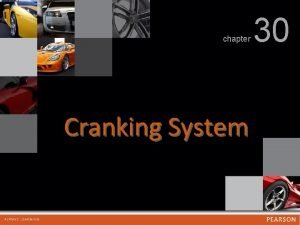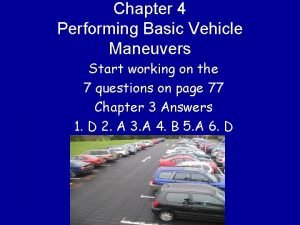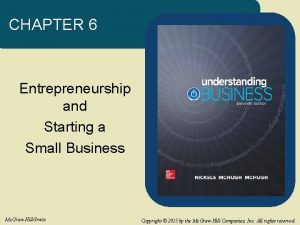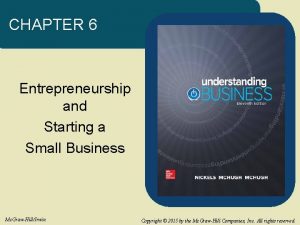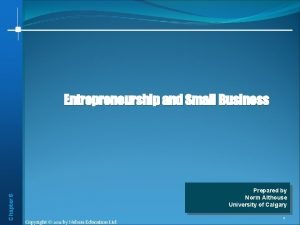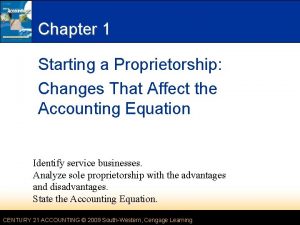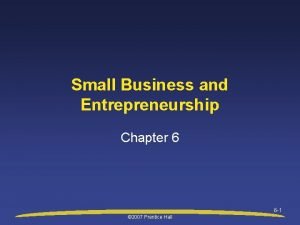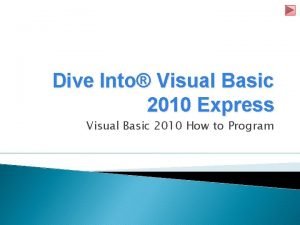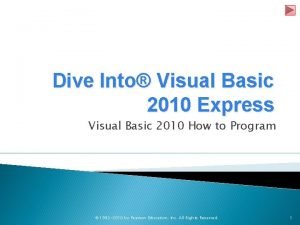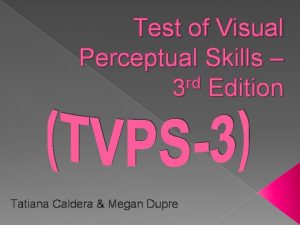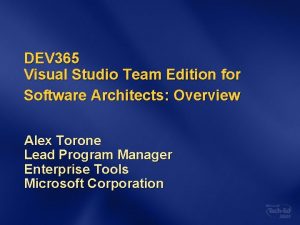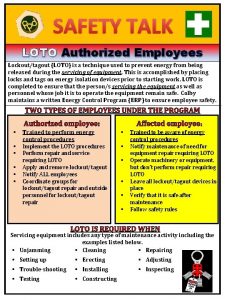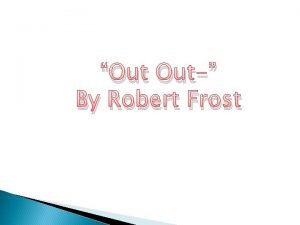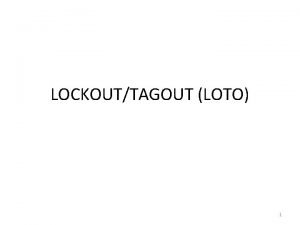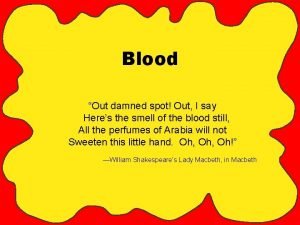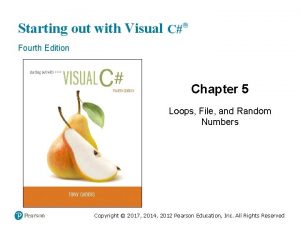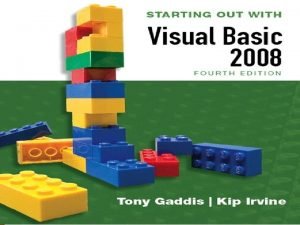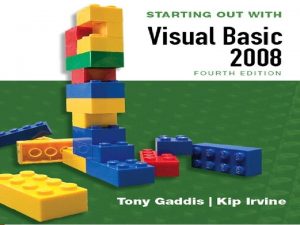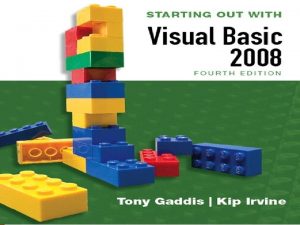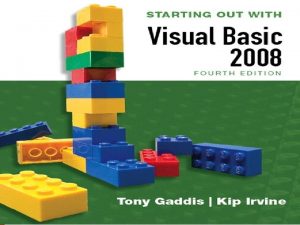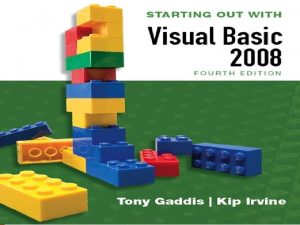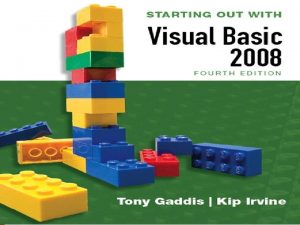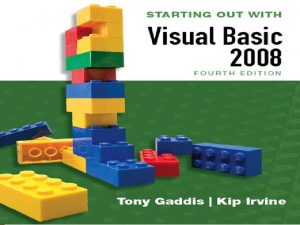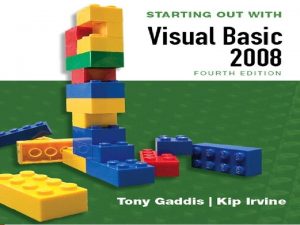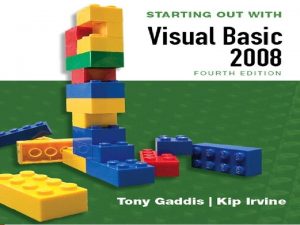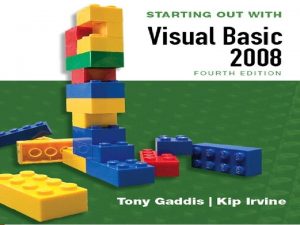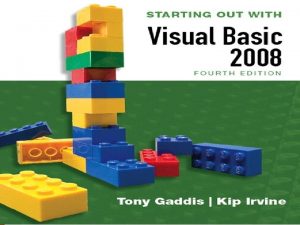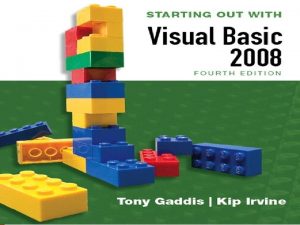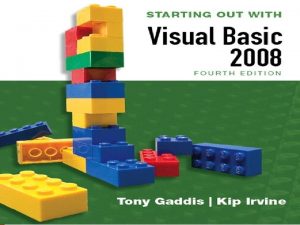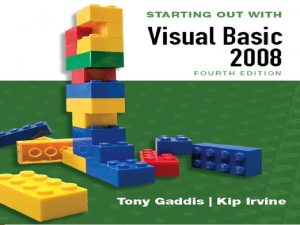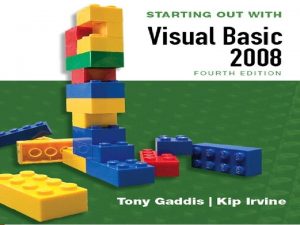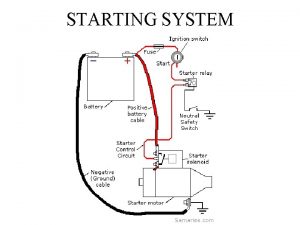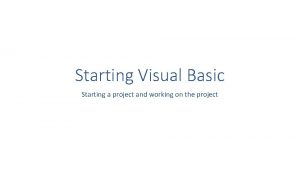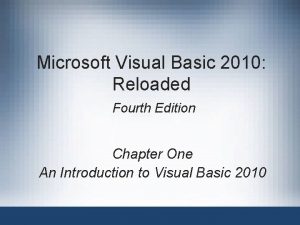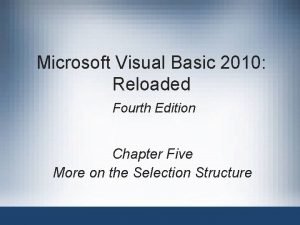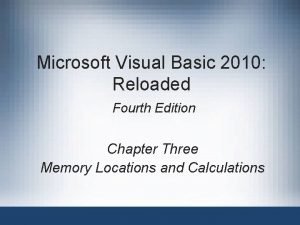Starting out with Visual Fourth Edition Chapter 4































- Slides: 31

Starting out with Visual Fourth Edition Chapter 4 Making Decisions Copyright © 2017, 2014, 2012 Pearson Education, Inc. All Rights Reserved

Topics (1 of 2) 4. 1 Decision Structures and the if Statement 4. 2 The if-else Statement 4. 3 Nested Decision Structures 4. 4 Logical Operators 4. 5 bool Variables and Flags 4. 6 Comparing Strings Copyright © 2017, 2014, 2012 Pearson Education, Inc. All Rights Reserved

Topics (2 of 2) 4. 7 Preventing Data Conversion Exceptions with the Try. Parse Method 4. 8 Input Validation 4. 9 Radio Buttons and Check. Boxes 4. 10 The switch Statement 4. 11 Introduction to List Boxes Copyright © 2017, 2014, 2012 Pearson Education, Inc. All Rights Reserved

4. 1 Decision Structures • A control structure is a logical design that controls the order in which statements execute • A sequence structure is a set of statements that execute in the order that they appear • A decision structure execute statements only under certain circumstances – A specific action is performed only if a certain condition exists – Also known as a selection structure Copyright © 2017, 2014, 2012 Pearson Education, Inc. All Rights Reserved

A Simple Decision Structure • The flowchart is a single-alternative decision structure • It provides only one alternative path of execution you can use the if statement to • In write such structures. A generic format is: • The expression is a Boolean expression that can be evaluated as either true or false Copyright © 2017, 2014, 2012 Pearson Education, Inc. All Rights Reserved

Relational Operators • A relational operator determines whether a specific relationship exists between two values Operator Meaning Expression Meaning > Greater than x>y Is x greater than y? < Less than x<y Is x less than y? >= Greater than or equal to x >= y Is x greater than or equal to y? <= Less than or equal to x <= y Is x less than or equal to you? == Equal to x == y Is x equal to y? != Not equal to x != y Is x not equal to you? Copyright © 2017, 2014, 2012 Pearson Education, Inc. All Rights Reserved

if Statement with Boolean Expression Copyright © 2017, 2014, 2012 Pearson Education, Inc. All Rights Reserved

4. 2 The if-else Statement • An if-else statement will execute one block of statement if its Boolean expression is true or another block if its Boolean expression is false • It has two parts: an if clause and an else clause • In a generic format looks: Copyright © 2017, 2014, 2012 Pearson Education, Inc. All Rights Reserved

Example of if-else Statement Copyright © 2017, 2014, 2012 Pearson Education, Inc. All Rights Reserved

4. 3 Nested Decision Structures • You can create nested decision structures to test more than one condition. • Nested means “one inside another” • In a generic format is: Copyright © 2017, 2014, 2012 Pearson Education, Inc. All Rights Reserved

A Sample Nested Decision Structure (1 of 2) Copyright © 2017, 2014, 2012 Pearson Education, Inc. All Rights Reserved

A Sample Nested Decision Structure (2 of 2) Copyright © 2017, 2014, 2012 Pearson Education, Inc. All Rights Reserved

The if-else-if Statement • You can also create a decision structure that evaluates multiple conditions to make the final decision using the if-else-if statement • In the generic format is: Copyright © 2017, 2014, 2012 Pearson Education, Inc. All Rights Reserved

4. 4 Logical Operators • The logical AND operator (&&) and the logical OR operator (||) allow you to connect multiple Boolean expressions to create a compound expression • The logical NOT operator (!) reverses the truth of a Boolean expression Operator Meaning Description && AND Both subexpression must be true for the compound expression to be true || OR One or both subexpression must be true for the compound expression to be true ! NOT It negates (reverses) the value to its opposite one. Expression Meaning x >y && a < b Is x greater than y AND is a less than b? x == y || x == z Is x equal to y OR is x equal to z? ! (x > y) Is the expression x > y NOT true? Copyright © 2017, 2014, 2012 Pearson Education, Inc. All Rights Reserved

Sample Decision Structures with Logical Operators • The && operator • The || operator • The ! Operator Copyright © 2017, 2014, 2012 Pearson Education, Inc. All Rights Reserved

4. 5 bool Variables and Flags • You can store the values true or false in bool variables, which are commonly used as flags • A flag is a variable that signals when some condition exists in the program – False – indicates the condition does not exist – True – indicates the condition exists Copyright © 2017, 2014, 2012 Pearson Education, Inc. All Rights Reserved

4. 6 Comparing Strings • You can use certain relational operators and methods to compare strings. For example, – The == operator can compare two strings – You can compare string variables with string literals, too – The String. Compare method can compare two strings Copyright © 2017, 2014, 2012 Pearson Education, Inc. All Rights Reserved

4. 7 Preventing Data Conversion Exception • Exception should be prevented when possible • The Try. Parse methods can prevent exceptions caused by users entering invalid data – int. Try. Parse – doubel. Try. Parse – decimal. Try. Parse • The generic syntax is: • The out keyword is required; it specifies that the target. Variable is an output variable Copyright © 2017, 2014, 2012 Pearson Education, Inc. All Rights Reserved

Samples of Try. Parse Methods Copyright © 2017, 2014, 2012 Pearson Education, Inc. All Rights Reserved

4. 8 Input Validation • Input validation is the process of inspecting data that has been entered into a program to make sure it is valid before it is used • Try. Parse methods check if the user enters the data, but it does not check the integrity of the data. For example, – In a payroll program we might validate the number of hours worked. – In a program that gets test scores, we can limits data to an integer range of 0 through 100. Copyright © 2017, 2014, 2012 Pearson Education, Inc. All Rights Reserved

4. 9 Radio Buttons and Check Boxes • Radio buttons allow users to select one choice from several possible choices – Clicking on a radio button, the program automatically deselects any others. This is known as mutually exclusive selection • Check boxes allows users to select multiple options Copyright © 2017, 2014, 2012 Pearson Education, Inc. All Rights Reserved

Radiobutton Control • The. NET Framework provides the Radio. Button Control for you to create a group of radio buttons • Common properties are: – Text: holds the text that is displayed next to the radio button – Checked: a Boolean property that determines whether the control is selected or deselected Copyright © 2017, 2014, 2012 Pearson Education, Inc. All Rights Reserved

Working with Radio Buttons in Code • In code, use a decision structure to determine whether a Radio. Button is selected. For example, • You do not need to use the == operator, although the following is equivalent to the above Copyright © 2017, 2014, 2012 Pearson Education, Inc. All Rights Reserved

Checkbox Control • The. NET Framework provide the Check. Box Control for you to give the user an option, such as true/false or yes/no • Common properties are: – Text: holds the text that is displayed next to the radio button – Checked: a Boolean property that determines whether the control is selected or deselected • In code, use a decision structure to determine whether a Check. Box is selected. For example, Copyright © 2017, 2014, 2012 Pearson Education, Inc. All Rights Reserved

The Checked. Changed Event • Anything a Radio. Button or a Check. Box control's Checked property changes, a Checked. Changed event is raised • You can create a Checked. Changed event handler and write codes to respond to the event • Double click the control in the Designer to create an empty Checked. Changed event handler similar to: Copyright © 2017, 2014, 2012 Pearson Education, Inc. All Rights Reserved

4. 10 The switch Statement • The switch statement lets the value of a variable or an expression determine which path of execution the program will take • It is a multiple-alternative decision structure • It can be used as an alternative to an if-else-if statement that tests the same variable or expression for several different values Copyright © 2017, 2014, 2012 Pearson Education, Inc. All Rights Reserved

Generic Format of the switch Statement • The test. Expression is a variable or an expression that given an integer, string, or bool value. Yet, it cannot be a floating-point or decimal value. • Each case is an individual subsection containing one or more statements, followed by a break statement • The default section is optional and is designed for a situation that the test. Expression will not match with any of the case Copyright © 2017, 2014, 2012 Pearson Education, Inc. All Rights Reserved

Sample switch Statement Copyright © 2017, 2014, 2012 Pearson Education, Inc. All Rights Reserved

4. 11 Introduction to List Boxes • A list box displays a list of items and allow the user to select an item from the list • In you can use the List. Box control to create a list box • Commonly used properties are: – Text: Gets or searches for the text of the currently selected item in the List. Box – Items: Gets the items of the List. Box – Selected. Item: Gets or sets the currently selected item in the List. Box. When the user selects an item, the item is stored in this property. You can use the following to get the selected item from a list box: – Selected. Index: Gets or sets the zero-based index of the currently selected item in a List. Box Copyright © 2017, 2014, 2012 Pearson Education, Inc. All Rights Reserved

Selecteditem • An exception will occur if you try to get the value of a List. Box’s Selected. Item property when no item is selected • Items in a list box have an index starting with 0 – The first item has index 0, the nth item has index n-1 – The Selected. Index property keeps the index. If no item is selected the, value of Selected. Index is -1 • The following is an example to use Selected. Index property to make sure that an item is selected before you get the value from Selected. Item. Copyright © 2017, 2014, 2012 Pearson Education, Inc. All Rights Reserved

Copyright © 2017, 2014, 2012 Pearson Education, Inc. All Rights Reserved
 Project 2 fourth edition
Project 2 fourth edition Pathways algebra 2
Pathways algebra 2 Ethics in information technology fourth edition
Ethics in information technology fourth edition Ethics in information technology fourth edition
Ethics in information technology fourth edition Project 4 fourth edition
Project 4 fourth edition Discrete mathematics with applications fourth edition
Discrete mathematics with applications fourth edition Expert systems: principles and programming, fourth edition
Expert systems: principles and programming, fourth edition Shot me out of the sky you're my kryptonite
Shot me out of the sky you're my kryptonite Using mis (10th edition) 10th edition
Using mis (10th edition) 10th edition Chapter 1
Chapter 1 Chapter 30 engine starting systems
Chapter 30 engine starting systems Chapter 4 performing basic maneuvers page 28 answer key
Chapter 4 performing basic maneuvers page 28 answer key Chapter 6 entrepreneurship and starting a small business
Chapter 6 entrepreneurship and starting a small business Chapter 6 entrepreneurship and starting a small business
Chapter 6 entrepreneurship and starting a small business Entrepreneurship chapter 6
Entrepreneurship chapter 6 Chapter 1 starting a proprietorship
Chapter 1 starting a proprietorship Chapter 6 entrepreneurship and starting a small business
Chapter 6 entrepreneurship and starting a small business Visual studio 2010 express
Visual studio 2010 express Visual studio 2010 express
Visual studio 2010 express Test of visual perceptual skills 3rd edition
Test of visual perceptual skills 3rd edition Visual studio team edition for database professionals
Visual studio team edition for database professionals Apakah maksud visual pada kata pemrograman visual ?
Apakah maksud visual pada kata pemrograman visual ? Othello put out the light
Othello put out the light Robert frost poems
Robert frost poems Out of sight out of mind quote
Out of sight out of mind quote Personification in out out by robert frost
Personification in out out by robert frost Loto safety talk
Loto safety talk Out out frost
Out out frost Out of sight out of time
Out of sight out of time Self righteous
Self righteous Lock out tag out pictures
Lock out tag out pictures Out, damned spot! out, i say!
Out, damned spot! out, i say!
